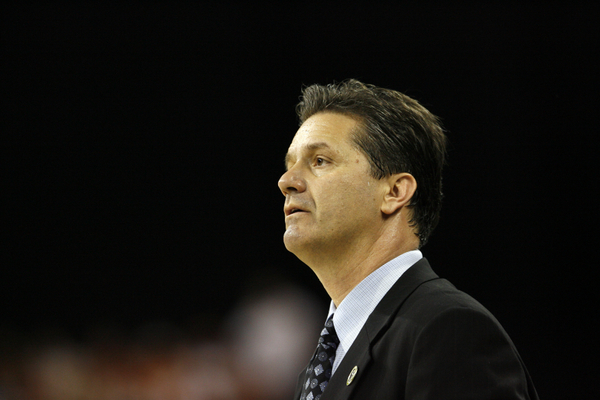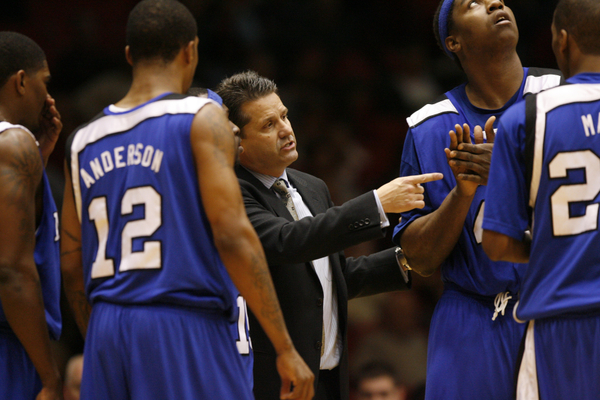It’s no secret that the high school Class of 2008 was one of the weakest in recent memory. Coming into the 2008-09 regular season, could you realistically point to any one player who would impact their team enough to become another Derrick Rose or a Michael Beasley (class of 2007), a Greg Oden or a Kevin Durant (class of 2006)? No way, right? The consensus #1 player, Brandon Jennings, high-tailed it to Europe when it became apparent he wasn’t going to become eligible to play college ball at Arizona, where he proceeded to burn up foreign nets at the clip of 6 ppg and 2 apg in limited action (17 mpg). The rest of the elite remained stateside, but from Jrue Holiday on down to his teammate Malcolm Lee at UCLA, the collegians too had middling degrees of success. We use the RSCI top 20 ratings provided by Statsheet for our table below.

The last two summers (here are 2007 and 2008), we’ve taken it upon ourselves to review how these one-and-dones did during their freshman year to determine whether their presence on campus for a mere 6-8 months was worth it for the schools involved. As it turned out this time around, only four college freshmen (+ Jennings) thought they were ready for the NBA Draft after only one season, so let’s take a look at how things turned out for them and their teams last year.
2009 One-and-Dones
Memphis – Worth It. After losing three starters from their 2008 national runner-up team, Memphis could have slid back into relative mediocrity by Tiger standards – very good, but not great. One-and-doner Tyreke Evans prevented that from happening. He averaged 17/5/4 assts/2 stls in 29 mpg and was the most efficient player on the team. He also showed that he was a gamer, dropping 33 huge points in the Tigers’ loss to Missouri and leading a furious comeback from 24 points down in that contest. More importantly, Memphis was 6-3 and ranked #24 in the nation when Evans moved from the shooting guard to the point guard slot; the Tigers then ran off 27 straight wins en route to a #2 seed and another Sweet Sixteen appearance, much of it due to Evans’ command of the team. Furthermore, prior to John Calipari’s departure, Memphis was building a pretty impressive reputation as a successful stopover for NBA-level point guards. Is there any coincidence that John Wall followed Calipari to Kentucky after seeing what Evans and Rose were able to do at Memphis? We’d have to say that Tyreke Evans coming to Memphis for one year was most definitely worth it for that program.
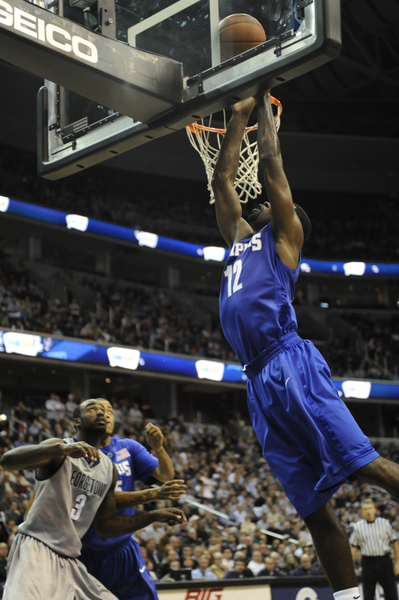
USC – Worth It. USC knew when they signed Demar DeRozan that they were unlikely to have this acrobatic swingman on campus for more than one year. For much of that year, however, it wasn’t looking like a good fit. Three points in a loss vs. Seton Hall. A 2-9 shooting night against Missouri. Six turnovers and fouling out of another loss at Washington. But around midseason, as things began to click in DeRozan’s game, USC benefitted. He provided a consistent threat on the wing and may arguably have been the Trojans’ top option in the last six weeks of the season. His season numbers were good – 14/6 on 52% shooting – but his stats from February on were better – 16/7 on 54% shooting with 22 of his season-total 51 assists coming in the last nine games. USC rode DeRozan’s playmaking abilities to win its first-ever Pac-10 Tournament and a convincing win over BC in the NCAAs before succumbing to national runner-up Michigan St in the second round. Or, in others words, more than what OJ Mayo was able to produce as a one-and-doner in 2007. Notwithstanding all the choas that has enveloped this program in the interim, we’d have to say that getting DeRozan to USC for one year was worth it.
Ohio St. – Not Worth It. For the third year in a row, Thad Matta lost a one-and-done player whose actual performance during his only season in Columbus didn’t really mesh with what you might expect from an elite prospect. He lost Daequan Cook in 2007 (along with stars Greg Oden and Mike Conley, Jr.), Kosta Koufos last year, and BJ Mullens this season. To date, we’ve yet to see any indication that Mullens has any discernible basketball skill other than being big (7’0). He averaged 9/5 in about 20 mpg with only two starts over the course of the season, but as an indication of how much Matta ultimately valued him, Mullens’ minutes tailed off considerably in the last 6-8 games. His defense was often considered suspect (37 blks all season) and he earned a reputation for loafing and failing to get back downcourt after an offensive possession. OSU had a solid season, mostly on the back of super-soph Evan Turner, but it’s difficult to construct an argument that Mullens brought much of anything to the Buckeye program other than an ability to get drafted in the first round. Ultimately, that may have been all Matta wanted to get from him, as he’s shown a substantial willingness to take one-and-dones every year that he can. Still, we don’t think that Mullens was on balance a good pickup for the Buckeyes, so we’re saying that he wasn’t worth it.
UCLA – Not Worth It. After Kevin Love’s departure from Westwood as a one-and-done, we thought UCLA might continue that trend this season with another superb guard ranked #2 in his class named Jrue Holiday. We were wrong. Holiday is exceptionally athletic, but he never seemed to ‘get it’ with respect to how Ben Howland runs his team and expects his players to execute. When we watched Holiday play, we saw a player who had a tendency to play out of control and get frustrated when things weren’t going his way (in other words, like most freshmen). Had Holiday stuck around for another couple of years at UCLA, he probably could have tamed his tendencies to become an elite guard in college basketball, but we’ll never know. After averaging a mere 9/4/4 assts as a starter who seriously tailed off down the stretch (single figure points in 10 of his last 13 games) ending in a second round NCAA blowout loss to Villanova, Howland may be questioning why he bothered to take this player for only one season. His contributions to the program were minimal and his general unhappiness with the program could actually end up hurting UCLA’s recruiting in the future more than it ever helps to have gotten him. Unlike Demar DeRozan across town at USC, Holiday wasn’t worth it.
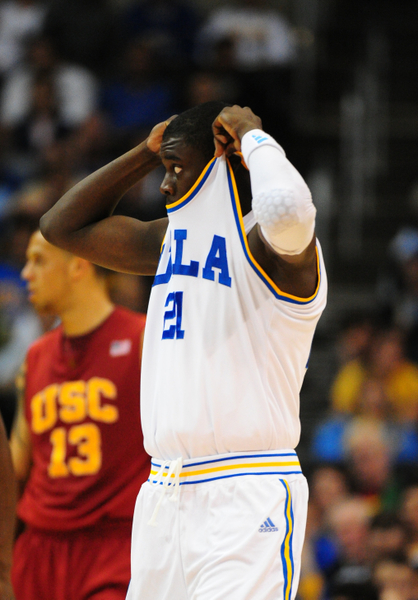
*Brandon Jennings – Push. Of course, this is a weird situation because Jennings didn’t play for an American college last season, instead deciding to go to the Italian leagues and get paid for his services. He would have been drafted higher last season had he been eligible to come out, but then again, so would have all these one-and-doners except for Evans (who at #4 is about where he would have been last year). Playing in Europe didn’t hurt him very much despite his paltry stats, but it didn’t appear to help him, either, in any way other than financially. It’ll be interesting to watch how he develops in the NBA now. You’d have to believe that Jennings’ previously indomitable confidence would be somewhat tempered after spending a year as the backup-cum-waterboy. We’re quite certain he had images in his head of going to Italy and winning MVP in his rookie season, but the broken American basketball system doesn’t exactly inspire schoolboy humility. Will that carry over to his development as an NBA player, or will he be able to accept his European comeuppance and use that to improve his game in the next few years? There’s no way of knowing at this point.
One-and-Dones: Historical Snapshot
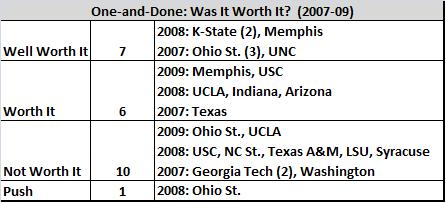
As stated above, RTC has done this for the three years in which the one-and-done rule has been in existence. We’ve made a qualitative determination as to whether recruiting a particular one-and-done was worth it for each program, and what we’ve found is that so far it’s been a roughly equivalent proposition. Of the 24 one-and-dones in three years, we’ve found thirteen instances (57%) where the player in question was either worth it or well worth it, “it” being the trouble of landing a top player and dealing with the disruption and potential hole he leaves in the program after one season. Additionally, in seven of the thirteen ‘worth it’ instances, we found that the player was such a great boost to the program in terms of success and marketing that the residual effects of his presence there will be felt for many years after he’s gone (e.g., OSU and Memphis making it to the NCAA Championship Game). On the other hand, we can only count ten occasions (42%) where a one-and-done player wasn’t worth the trouble of getting him into the program. So let’s look at it this way… if you were a college coach and you knew you had a historically better than even chance that recruiting a John Wall or Derrick Favors would end up making your program better, and a 25-30% chance of truly elevating your program into an elite echelon, there’s no question you do it, right? What’s the downside? Your player doesn’t do a whole lot, leaves after one year and you end up where you were before he got there. Exactly. Not only is recruiting one-and-dones worth the risk (so long as you’re doing it legally, Tim Floyd), but if you’re not doing it then you’re putting yourself at a serious competitive disadvantage.





























